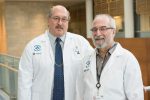Dr. Mark Freedman, left, and Dr. Harold Atkins. (photo from Ottawa Hospital)
A Canadian research team led by Dr. Mark Freedman and Dr. Harold Atkins at Ottawa Hospital has managed to reverse severe multiple sclerosis (MS) using a patient’s own stem cells.
Freedman is a professor of neurology at the University of Ottawa, a senior scientist at the Ottawa Hospital Research Institute and the director of the Multiple Sclerosis Research Clinic.
“Considering the fact that, when I got into this business, no one even knew what MS was, then, following that, they didn’t know what to do with it, there were certainly no treatments available,” Freedman told the Independent. “So, we had to gain an understanding of some of the processes involved…. We’ve since come up with therapies that have been very effective in dealing with the disease.”
According to Freedman, “MS is a condition that refers to very specific immune system irregularity where, instead of being the defence of the body, the body mistakenly believes that the lining (called myelin), the insulation of the wires of the central nervous system, contains something foreign and proceeds to reject it. This rejection is going to live as long as the body believes the myelin is foreign or that foreign parts exist in it … which means, it’s a lifelong disease, as the immune system will continue to attack the myelin.”
Freedman went on to describe the immune system as an army in our body that is both there to protect us from foreign bodies, like viruses and cell mutations, such as cancer, and is also there to help us heal.
The problem is, in cases where the immune system turns on healthy body cells, Freedman said, “If you can’t identify who the bad guys are in the army – that’s been the attempt in the last 20 to 30 years – then you have to decide whether or not to hold back the entire army. If you do that, you take away protection from the body.
“We’ve always been caught between a rock and a hard place by allowing the army to function, [but] trying to at least curb its function when it comes to attacking the brain. All the therapies that have been developed, more or less, try to handcuff the army a little bit and prevent it from attacking the central nervous system.”
In trying to distinguish the good guys from the bad, researchers have found that each individual’s MS presents unique good guys and bad guys; not only different ones but at different times.
Freedman and his team wanted to find a way to eliminate the entire immune system with a mix of chemotherapy drugs, enabling them to start fresh, using a patient’s stem cells. “What if we flushed out the entire army and built in a brand new one?” he proposed. “This, theoretically, would not have the same mistakes, where it believes the central nervous system myelin is foreign and will attack.
“What we found out was, in fact, that, regardless of the genetic makeup of the individual, the disease ceased once we replaced the entire immune system. The trick was to do what no one else had done.”
The treatment starts by extracting stem cells from the patient and cleaning them, ensuring there is nothing remaining with the same cell mixture that may carry over the disease once the stem cells are replanted.
After killing off the entire immune system, which, Freedman pointed out, “of course has some dangers associated with it,” he said, “technology allows us to do that with success. After that, very quickly, patients settled down. They no longer had MS attacks and, over many years, their body started to heal.”
In a sense, Freedman and the team created a reset button for the immune system.
“Having a competent immune system that no longer attacks the central nervous system and can actually heal, we saw that, in our patients, it wasn’t just a short-term phenomenon,” he said. “We followed them for more than a decade.”
Freedman believes that anyone with MS can benefit from the procedure, with the important cautionary caveat that, as the procedure is complex and has risks, someone with a mild case of MS who can be treated with currently available therapies might not want to have it done.
“For some people, the risk is not necessary,” said Freedman. “But, for other patients who have disease that is quite aggressive and not easily amenable to treatment, these are the patients who should probably go this route.”
Freedman and his team are continually looking for ways to reduce the toxicity of the treatment, while also looking for ways to determine which patients are more likely to recover well. “In the meantime, we continue to use the treatments for patients who we deem early enough to respond to the treatment, at a stage that it will offer them some help,” he said.
“Unfortunately, everyone with MS comes out of the woodwork when you say you’ve got something … people who have been in wheelchairs for 25 years wanting to be signed up, as they feel they have nothing to lose. Well, you have your life. You could lose that. We aren’t ready to jump on such patients, as it could be inappropriate.”
Freedman advised that patients first speak with their neurologist, who hopefully understands their disease and can advise them whether or not this is a treatment they should consider.
“It’s not something that a patient can decide on their own,” said Freedman. “This isn’t a treatment that’s for sale. We want to help people who can be helped. We apply treatments to people who are likely to benefit and who are unlikely to be harmed.”
Rebeca Kuropatwa is a Winnipeg freelance writer.

